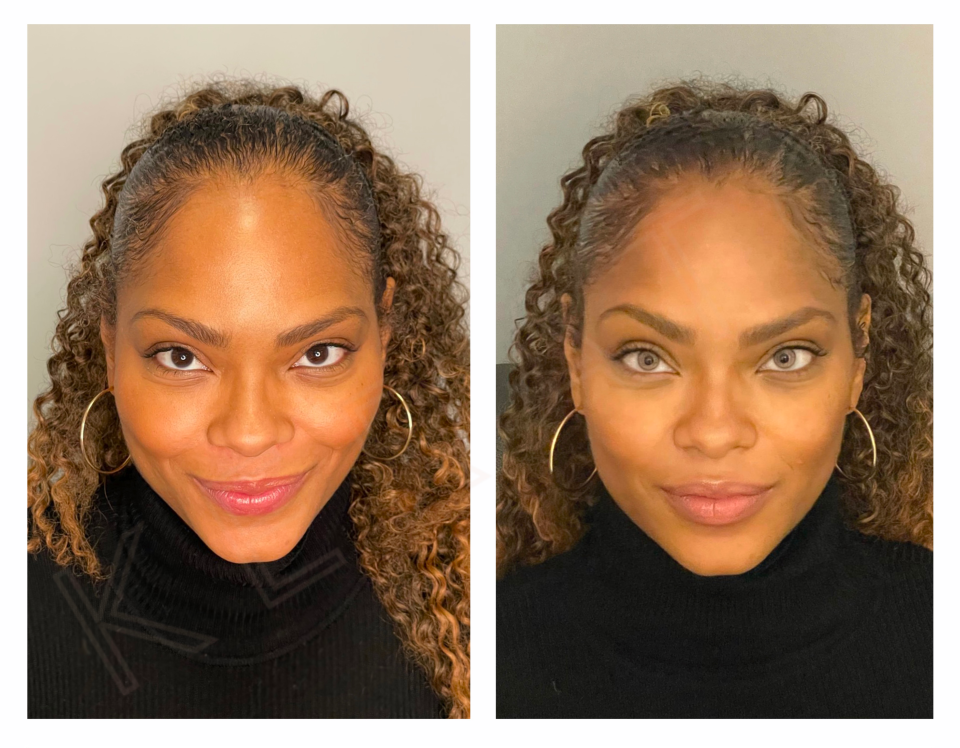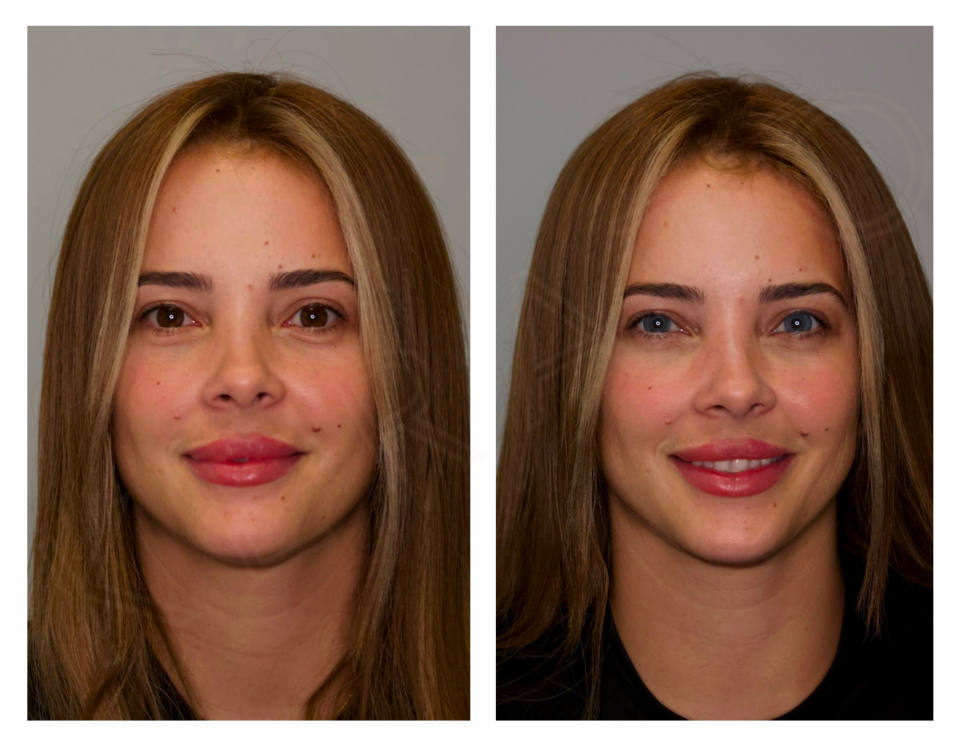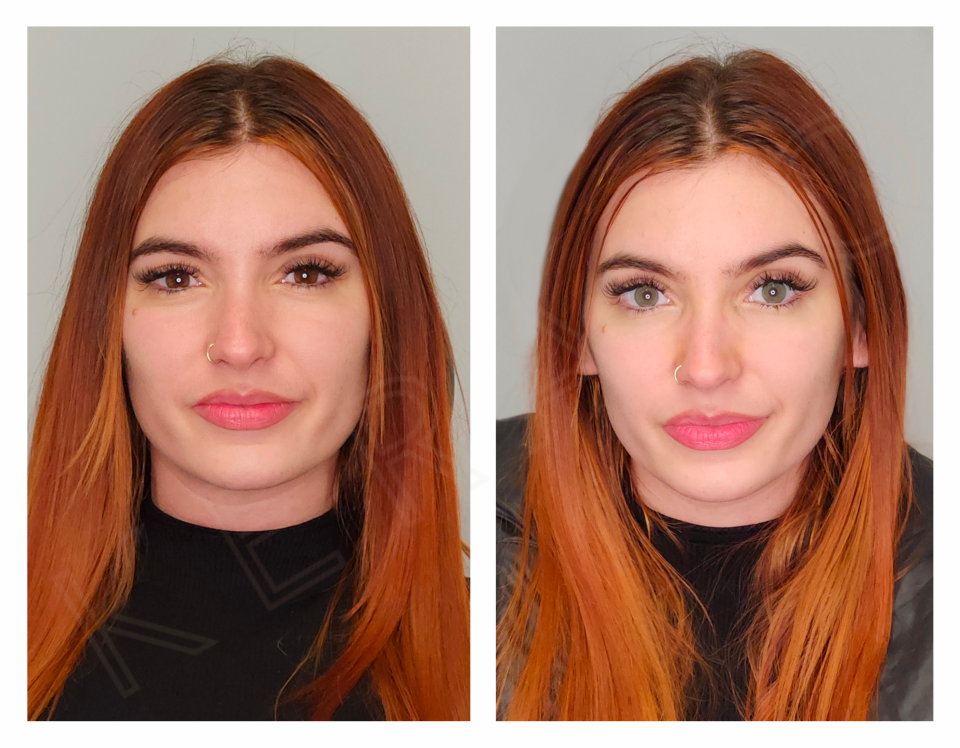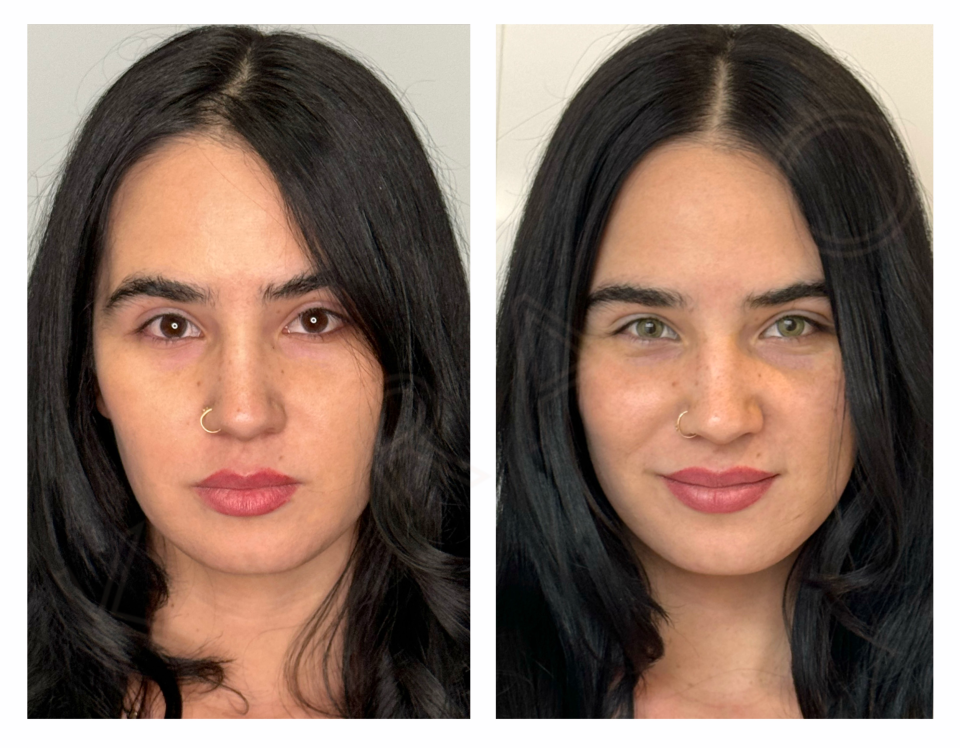Want Green Eyes? That'll Be $12,000

Sarah Krick/Gallery Stock
Iris is getting her eye color changed today. She is 40, an engineer, and anxious, almost shaking. In a featherlight voice that just barely rises above the chatter from a full waiting room nearby, she explains her love of the cosmetic arts, which is apparent from the moment she is beheld—her body is an hourglass that appears to run on Brasilia Standard Time—but can also be gleaned from her palpable excitement over the fact that, in minutes, a laser will bore a round tunnel into her cornea and be filled with blue pigment. And all it costs is 20 minutes and $12,000 dollars. “I’m going for an Alaskan-husky type of color,” Iris told me. (That’s not her real name—can you imagine if it was?) She wants her gaze to be visible from a distance.
Keratopigmentation, a procedure to permanently change one’s eye color that has been performed for at least a decade in Europe, is gaining popularity in the United States. Only a handful of clinics in the US currently offer the procedure, with half of them located in the New York City metropolitan area.
Kerato sits on the 8th floor of a midtown office building, and is bustling by 10am with patients who have paid for a new eye color, and others getting some Lasik. But when I arrived an hour beforehand, it was just me and Alexander Movshovich, the first doctor to bring keratopigmentation (KTP) to America. (Dr. Movshovich is not only a board-certified ophthalmologist but also a photographer, and his office is decorated by his own abstract glimpses: the stamen of a crocus flower in bloom, a crystal ball refracting a crimson room.)
A doctor in his native Russia, Dr. Movshovich moved to the United States some four decades ago. He wound up at Cornell, where he re-enrolled in school, completed a residency in ophthalmology and a fellowship in vitreoretinal disease and surgery, and began practicing retinal surgery. “Complicated cases of cataracts and stuff like that,” he explained, in a Russian accent. “My life is very much research.” After 30 years of research, he became interested in trying something new. Then he heard about a friend of his, the retinal surgeon Francis Ferrari, who was working on an exciting new technique for changing eye color in France. In 2019, he opened Kerato.

Until recently, eye color change could be achieved in one of a few imperfect ways. Color contacts have been around since old Hollywood, and today are considered the safest option; at least, they are the only method the American Academy of Ophthalmologists (AAO) blesses.
Iris implants, fine silicone prosthetics designed to be surgically placed over an existing iris by cutting a slit in the cornea, are less than beloved by the AAO, and usually need to be removed in a matter of years. They have been infamous since Tiny Cottle, the wife of the rapper T.I., traveled to Tunisia in 2014 for BrightOcular implants. She posted a review and discount code on her Instagram; later that year, the AAO strongly cautioned against the procedure, citing its risks of reduced vision or blindness, cataracts, injury to the iris and cornea, and a pressure build-up inside the eye that can lead to glaucoma.
There’s also laser depigmentation, in which a laser fries the natural pigment of your iris into a lighter shade, but it isn’t very customizable. Champions of this sort of decoloration include Stroma Medical, which predicts that its proprietary laser will generate around $3 billion a year from the pockets of those who want to change their brown eyes blue. The Stroma Laser System is “an investigational device not available for sale for use in the United States,” according to boilerplate text on its website, and it has not been approved by the FDA.
Nor has anything else—including KTP. An FDA spokesperson told Allure that the agency “is not aware of any medical devices with an FDA-approved indication solely to permanently change an individual’s eye color or of any pigments for that use.”
For more than a decade, doctors like Ferrari and Jorge Alió have been performing the KTP procedure and teaching it to doctors like Movshovich. Alió, a Spanish surgeon, was the first physician to perform it—initially for therapeutic purposes, like retinal detachment and cases of albinism, before moving into cosmetic purposes. In the ‘90s, “I discovered that I could change the color of the eye of any person to any color,” he said. He performed the first cosmetic KTP procedure in 1999, he says. Perhaps the first documented cosmetic KTP procedure, though, was in 2013 as conducted by Dr. Ferrari; his method was published in the Journal Français d'Ophtalmologie two years later.
Dr. Alió and his cohort say that they have observed the long-term effects of KTP after about 11 years of experimental animal and patient studies—published in places like the British Journal of Ophthalmology, the Journal of Cataract and Refractive Surgery, and Cornea—but we’re still about a decade short of the “very long-term” benchmark. The British Journal of Ophthalmology study of 204 patients produced a 12% complication rate—mostly light sensitivity and some color fade from the original result. In a subsequent study of 40 patients, about a third reported some light sensitivity. Dr. Movshovich has a tendency to answer questions with approximate percentages, and estimates that 7% of his patients have opted to go back under the laser to tinker with the shade, including one who wanted a high-intensity color that came with a longer period of inflammation. (The more intense the color, the more likely inflammation is to occur over a period of about two to three months.) But Dr. Movshovich wants to point out that KTP does not cause blindness, and the complications themselves aren’t vastly different from those associated with Lasik, and, anyway, 97% of his patients have left happy.

KTP is performed using a corneal refractive laser off-label, and uses a mineral-based pigment that is inert when inserted into the translucent cornea using a cannula. Doctors have observed how micronized mineral pigments interact with the cornea for decades, and probably longer; Galen, the ancient Roman physician, has written about performing corneal tattooing to correct cloudiness—or leukomata—as early as 129 A.D. using a reduced copper sulfate. Earlier this year, the AAO issued a warning about KTP, enumerating potential risks, including vision loss from possible bacterial infection. (A spokesperson for the AAO told Allure they are not currently aware of any cases of vision loss caused by the procedure.) A 2020 report on the procedure published by the Ophthalmological Society of the United Kingdom was generally bullish on the procedure, but noted a rare complication involving an eye and brain disease-causing parasite.
The general consensus among practitioners of KTP is, perhaps predictably, that KPT is safe; that the AAO is lagging behind; that the FDA will come around soon. “In America, everything is FDA questioned,” Movshovich said. “You need some guts, and enough research to not be scared to do it.”
“In America, everything is FDA questioned. You need some guts, and enough research to not be scared to do it.”
For now, though, long-term research is scarce—which is why some ophthalmologists are less than convinced that KTP is a good idea. “We only get one set of eyes, and to put them at risk in the name of vanity is ridiculous,” says Diane Hilal-Campo, a board-certified ophthalmologist based in Oakland, New Jersey. “While keratopigmentation may be considered 'safer' than other cosmetic options, none of them are truly safe. Beyond injury or infection, there's the risk of the pigment causing visual obstruction—remember, your pupil is an aperture that opens and closes when reacting to light or other stimuli.” She also points to the possibility of an allergic reaction to the pigments.
Others in the greater ophthalmology community pointed to the procedure’s permanence as reason enough for concern. “If a patient doesn’t like the result, can the pigment in the corneal tunnel be washed out?” wondered Kevin Miller, MD, a professor of clinical ophthalmology at the David Geffen School of Medicine at UCLA. “In other words, is it reversible?”
It isn’t. One day, it may become possible to remove the pigment, but there is no world in which corneal tunnels can be undug. This is in part why doctors like Alió believe that it’s not enough to have guts and want blue eyes; you have to need blue eyes, or, at least, be able to make the argument. If not, he declines to perform the procedure. “The reason why people are interested in the technique is cosmetic,” he says of his patients, “but they are cosmetic based on family issues, psychological problems, social problems.” His first patients were brides whose wedding nights were approaching, and whose husbands hadn’t seen their eyes without color contacts. He told me about an English patient with blue eyes who married an Afghani woman with brown eyes, and later, when their brown-eyed children beheld their father, they found him freakish. Dr. Alió turned his eyes brown, softening his gaze.

Iris is a common patient in that she’s a longtime color contact wearer who had grown tired of her daily insertions. Dr. Movshovich charges $12,000, about 50 years worth of dailies. The color selection process begins with Photoshop and the seven shades in Kerato’s palette, which cover the genetic spectrum—from syrupy brown to pure cerulean—and are largely made in France, either by a company called Biotic Phocéa or another called Neoris, in which Dr. Ferrari is a major stakeholder. The colors can be adjusted for intensity, though Dr. Movshovich prefers not to honor some requests. “Some people want to be dragons,” he said, seeming bemused. His patient breakdown is evenly split across genders, though he notices the typical patient is likely to have undergone some other cosmetic procedure. Eighty percent, he estimates, also have veneers.
KTP is about as uncomfortable as Lasik, with patients reporting a pressure sensation, but it’s relatively painless. The whole thing takes around 20 seconds on each eye, and then it's a matter of making sure the two match. A plastic surgeon I met earlier this year, who had recently gotten his eyes done at Kerato, recalled that it took his wife longer to get her nails done. The patient is able to inspect the color immediately post-op—in a mirror, in dark photos, and in naturally-lit photos—for tweaks, and spends the next 20 minutes in a comfortable, dim corridor outside the operating room. While their eyes adjust, Dr. Moshovich is onto the next pair.
Less than a block away from Dr. Moshovich’s office stands Manhattan Lasik Center, the East Coast’s other KTP clinic. The two have developed a rivalry on the permanent eye color change vanguard. Dr. Kevin Niksarli, like Movshovich, studied at Cornell, and learned about the procedure from Ferrari and Alió. “This procedure makes a significant difference in one’s self-image, self-perception, and self-confidence,” Dr. Niksarli told me. “In our practice, we do not take the psychological aspect lightly.”
Dr. Niksarli was last board-certified in ophthalmology in 1999. (“Since my sub-specialization has been Kerato-Refractive Surgery, which I have been exclusively practicing since 1997, I did not participate in the subsequent repeat examinations conducted every 10 years,” he explained, “as they are not required nor relevant to my specific area of expertise.”) He estimates that he has now done just under 1,000 KTP cases. “We're getting very popular nowadays,” he said. “People are very, very happy with the results.” About a fourth of Dr. Niksarli’s patient base has already undergone some refractive surgery, like Lasik. He offers 11 Neoris shades that offer slight variations from Kerato’s palette, including a jewel box of emeralds, and two shades of gray. Manhattan Lasik Center charges $13,000 for the procedure, but is offering a promo code, KERATO1000, on its website for $1K off.
80% of patients also have veneers.
The words quick, safe, and customizable are mentioned often enough that I wonder if it’s possible for a KTP patient to swap pigments quickly, like a video game character, once the channel is dug. Dr. Niksarli says, well, not exactly. “If they're not happy with the initial color, we can deviate from that. And we've done that several times,” he explained. But it becomes a matter of mixology. A green eye can be nudged toward gray or made lighter, but is hard to make blue or brown. A more substantial change could be achieved by digging a second KTP channel that is shallower than the first. “There is a bit of flexibility there,” he said. Whether it should be achieved is another matter, as repeated surgeries can increase one’s risk for complications.
Manhattan Lasik Center has made KTP available at four locations throughout the greater New York area. Dr. Movshovich is thinking of expanding Kerato to Miami, maybe Boston. He’s meeting with aspiring KTP surgeons, but he hopes to perfect the procedure before he bequeaths it in earnest. “I can teach this one when I get to be complete with the final technique, and final instrumentation,” he said. In a few months, the world’s KTP braintrust will meet in Alicante, Spain, for Kolor, the “first world congress on eye color change”; Alió, Moshovich, and a few other doctors sit on Kolor’s scientific committee.

As Iris was under the laser, I spent a few minutes talking to Dr. Movshovich’s wife, Paulina, who wore blonde curls and studded blue jeans. Her brown eyes are naturally brown, and when I asked if she might change that, she shook her head. “I’m scared of lasers,” she admitted. But she has seen many transformations, and each one continues to amaze her—how these patients emerge from the treatment room reborn. Some days she’ll come to the office to chat with patients and take photos for Kerato’s social media pages.
Iris’ eyes are done before we can finish our conversation. Now powder blue, her gaze pierces where it once fell, but the intensity was subtler than I expected. “I'd like to see what I look like with makeup now!” she said. She hasn’t told her friends or family about her trip to Kerato. “I want them to be like, ‘Oh, wow.’”
The doctor and his wife guided Iris to a beam of New York City sunlight, and his wife snapped a photo. “I never say this,” she told Iris, “but I like it more than your old color.”
Read more about aesthetic procedures:
Now watch the history of plastic surgery:
Follow Allure on Instagram and TikTok, or subscribe to our newsletter to stay up to date on all things beauty.
Originally Appeared on Allure

